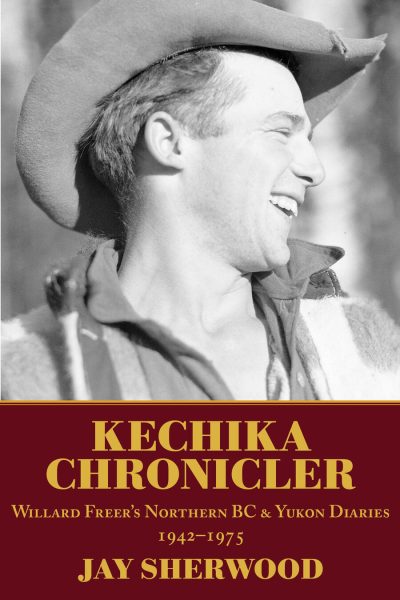
Kechika Chronicler: Willard Freer’s Northern BC & Yukon Diary, 1942-1975
Review By R. Scott Sheffield
March 4, 2024
BC Studies no. 220 Winter 2023/24 | p. 120-121
This is the last book on BC history by the late Jay Sherwood, a retired teacher and librarian, and tracks the remarkable life of Willard Freer (1910-1981). Raised in the Peace River district, a young Willard moved northwest to take up a trapline along the Ingenika River before finding his way north over the Sifton Pass to the Ketchika River in 1942. Living first with his employer, the legendary packer, rancher and guide, Skook Davidson, Freer built himself a cabin nearby that would be his home base until the mid-1970s. Sherwood narrates around the daily journal Willard kept throughout his life, augmented with archival research and the help of the Hudson Hope Museum and the families of Freer and Skook Davidson. Freer’s diary entries are succinct, detailing events of the day, including the weather, the flora and fauna, and the people he met. As such it provides a unique lens into a remote wilderness region rarely visible to historians’ gaze.
The author organised the book chronologically, with chapters on Freer’s early life, and then by decade from the 1940s to ‘70s. Freer arrived in northern BC as the region was on the cusp of change, with the Alaska Highway bringing in the outside world and shifting the economic patterns. Nevertheless, traditional activities like trapping and hunting would remain central to the way of life of many Indigenous and settler residents alike. Freer continued to trap, hunt and trade goods for furs taken by Tsek’ehne neighbours throughout his life. His primary summer occupation through to the 1960s was as a packer, wrangling horses and hauling supplies for government or business expeditions. He complemented this with guiding hunters and seasonal work at lodges along the Alaska Highway. The narrative is granted an immediacy by Freer’s terse description and contextual richness by Sherwood’s additions. The result is a genuinely valuable addition to the literature.
Sherwood makes selective use of the diary, including some dates intermingled with his own editorial summaries for portions of the year, sometimes months long. It is not clear the methodology by which this was done, though he mentioned in the introduction that Freer’s writing was “usually brief and direct, with minimal philosophizing”(15). Presumably his approach addresses the understandable repetition. In addition to summarising, Sherwood provides brief contextualisation of various people or events of interest along the way, sometimes in the stream of entries, other times in text boxes. These eclectic asides vary in depth and detail. Sherwood also touches on issues like the ecological changes of settler intrusion, the economic impact of the Alaska Highway, and the implications for Indigenous populations in the region. He regularly comments on Freer’s relationship with neighbouring Indigenous families, largely in a positive light. Interestingly the author mentions in the introduction that some entries reflected stereotypical beliefs towards Indigenous people but argues that these were broader views Freer had against laziness or excess drinking regardless of a person’s background. Yet, any entries that did stereotype Indigenous people are not included in the book. Also of note, when the local bush pilot came to collect First Nations children from Freer’s neighbours Sherwood mentions briefly the construction of the Lower Post Residential School. While critical, Sherwood’s coverage is brief and does not engage with that literature. As a result, several of these issues feel like opportunities lost to more fully contextualise Willard Freer’s experiences.
Overall, however, Jay Sherwood is to be commended for building around Freer’s austere journal entries with the collections, photos, and published works of those who encountered this remarkable bushman through his long and varied life. This was clearly a labour of love for the late author and the product of thoughtful research connecting quite disparate source materials. The result will be of value for anyone interested in the history of BC’s far north during the 20th century.
Publication Information
Sherwood, Jay. Kechika Chronicler: Willard Freer’s Northern BC & Yukon Diary, 1942-1975. Qualicum Beach, BC: Caitlin Press, 2023. 216 pp. $26.00 paper.
